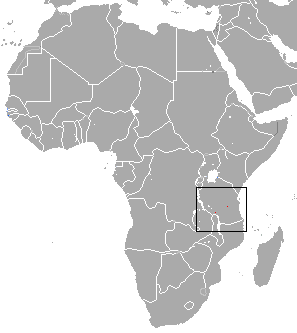Highland mangabey facts for kids
Quick facts for kids Kipunji |
|
|---|---|
 |
|
| Conservation status | |
| Scientific classification | |
| Genus: |
Rungwecebus
|
| Species: |
kipunji
|
 |
|
| Kipunji range | |
The kipunji (Rungwecebus kipunji), also called the highland mangabey, is a type of Old World monkey. It lives in the high forests of Tanzania, a country in Africa.
This monkey has a special call that sounds like a 'honk-bark'. This helps tell it apart from its relatives, like the grey-cheeked mangabey. Their calls sound more like 'whoop-gobbles'.
Scientists found the kipunji in 2003 and 2004. This was a big deal because it was the first new monkey species found in Africa since 1984! At first, scientists thought it belonged to a group called Lophocebus. But later, they learned it was more like baboons. So, they gave it a brand new group name: Rungwecebus. This name comes from Mount Rungwe, where some kipunjis live. It was the first new monkey group discovered since 1923.
Local people, the Nyakyusa people, had stories about this monkey. But for a long time, scientists weren't sure if it was real until they finally found it.
Contents
What Does the Kipunji Look Like?
The kipunji has long, light or medium brown fur. Its tail tip and belly are white. The fur near its hands and feet is usually a darker brown. Its hands, feet, and face are all black.
Male and female kipunjis look very similar in their fur color. Adult male kipunjis are about 85 to 90 centimeters (about 3 feet) long. They can weigh between 10 and 16 kilograms (about 22 to 35 pounds). One special thing about kipunjis is the wide crest of hair on top of their heads. This helps tell them apart from other similar monkeys.
Where Do Kipunjis Live?
About 1,100 kipunjis live in two separate areas. One group lives in the Ndundulu Forest Reserve, which is next to Udzungwa Mountains National Park. The other group lives about 250 miles away on Mount Rungwe and in Kitulo National Park.
The forest on Mount Rungwe is not in very good shape. It is broken into smaller pieces, which could split the kipunji population there into even smaller groups. The Ndundulu forest is healthier, but it has fewer kipunjis.
Protecting the Kipunji
The kipunji is listed as an endangered species on the IUCN Red List. This means it is at high risk of disappearing forever. It was also named one of "The World's 25 Most Endangered Primates" in 2006 and 2008.
These monkeys only live in a small area of forest, about 17.7 square kilometers (about 6.8 square miles). This small area is split between the Ndundulu forest and the Rungwe-Livingstone forest.
Threats to Kipunjis
Kipunjis face many dangers, mostly from people. Here are some of the main threats:
- Cutting down trees: People cut down trees for wood and to make charcoal. This destroys the kipunjis' home.
- Illegal hunting: Kipunjis are sometimes hunted using traps and dogs. This often happens from January to April. Hunters might target them if the monkeys eat crops from nearby farms.
- Habitat loss: Farmers are moving into the narrow forest areas that connect different parts of the kipunji's home. This makes it harder for the monkeys to move between groups.
- Lack of protection: Places like the Kilombero Nature Forest Reserve and Mount Rungwe Nature Reserves do not have enough resources to protect the kipunjis properly.


